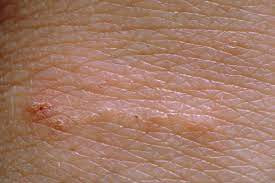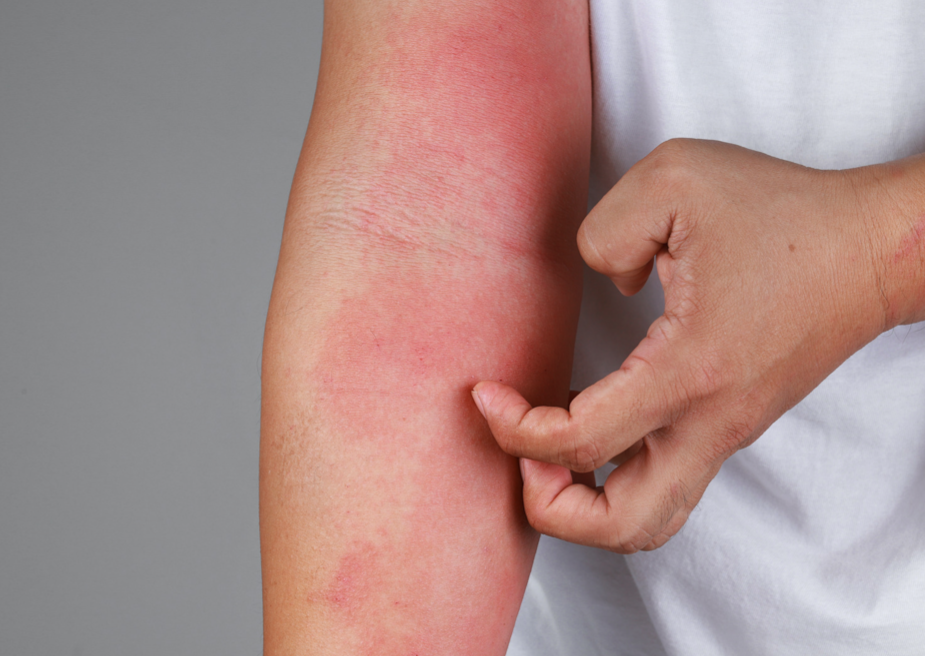Definisi
Skabies, atau dikenal juga dengan gudig atau kudis, merupakan penyakit infeksi kulit yang menular akibat tungau Sarcoptes scabiei yang membuat terowongan di dalam kulit dan dapat menimbulkan rasa gatal yang berat. Gatal yang dirasakan terutama pada malam hari akibat aktivitas tungau yang lebih aktif. Penularan scabies melalui kontak antar kulit atau tidak langsung melalui benda yang sudah terkontaminasi oleh tungau tersebut. Skabies dapat hidup pada tubuh manusia selama 1 – 2 bulan. Skabies biasanya terjadi pada area yang padat penduduk, fasilitas pelayanan umum, penjara, atau pesantren. Pada dewasa muda, scabies menular melalui kontak seksual dengan seseorang yang telah terinfeksi skabies. Skabies tidak menular melalui kontak dengan hewan.
Angka kejadian skabies di seluruh dunia diperkirakan sebanyak 200 juta kasus tiap tahunnya. Oleh karena itu, pada tahun 2009, Organisasi Kesehatan Dunia (World Health Organization) menyatakan skabies sebagai masalah kesehatan yang bermakna di beberapa negara berkembang dan merupakan penyakit kulit yang terabaikan.
Penyebab
Penyebab dari skabies adalah tungau Sarcoptes scabiei var homonis. Tungau ini dapat tinggal di lapisan dermis dan epidermis manusia. Penyakit scabies dimulai dengan adanya infestasi telur tungau betina yang membuat terowongan di dalam lapisan kulit yang disebut korneum. Telur tersebut lama kelamaan menjadi tungau dewasa dan siklus ini terus berulang apabila tidak ditangani dengan tepat sehingga seseorang mengalami gejala-gejala skabies terutama gatal yang berat di malam hari.
Faktor Risiko
Pengenalan mengenai beberapa faktor risiko sangat berperan penting dalam pencegahan hingga pengobatan skabies. Semua orang dapat saja berisiko mengalami skabies. Namun, ada beberapa faktor risiko yang lebih menentukan apakah Anda akan mengalami skabies atau tidak di masa depan.
Beberapa faktor risiko diantaranya:
- Kontak erat dengan orang diduga mengalami skabies
- Sering bertukar alat-alat mandi pribadi seperti handuk atau baju
- Tidur bersama dengan orang yang terinfeksi
Gejala
Gejala umumnya muncul dalam waktu 2 – 5 minggu setelah paparan pertama kali terhadap skabies. Gejala yang dapat dirasakan antara lain:
- Ruam kulit, biasanya di antara jari tangan dan kaki, bagian bawah pergelangan tangan, ketiak, payudara, dan bokong
- Sangat gatal terutama pada malam hari
- Rasa gatal yang berat akan menyebabkan siklus gatal dan garuk sehingga garukan dapat menyebabkan kulit mengalami infeksi bakteri sekunder. Apabila infeksi bakteri sekunder terjadi, maka obat tambahan seperti antibiotik diperlukan untuk menangani permasalahan ini.
Beberapa area tubuh yang sering menjadi tempat infeksi skabies, diantaranya siku, lipat siku, lipat ketiak, bokong, sela jari tangan, atau alat kelamin. Terkadang, terowongan tungau dapat terlihat di kulit dan tampak adanya perubahan warna (garis berwarna coklat kemerahan).
Diagnosis
Diagnosis skabies merupakan diagnosis klinis, artinya dokter dapat menetepkan diagnosis skabies melalui wawancara medis khusus dan pemeriksaan fisik pada umumnya melalui penampakan dari tampilan yang khas pada area yang terinfeksi skabies dan lokasi khas yang paling sering ditemukan skabies. Pemeriksaan fisik yang dapat ditemukan pada skabies biasanya bintil-bintil merah yang terasa sangat gatal. Selain itu, terowongan tungau dapat terlihat.
Sebaiknya Anda beritahu dokter apabila Anda atau keluarga Anda sedang atau pernah mengalami skabies sebelumnya. Informasi seperti kapan pertama kali gejala muncul juga akan membantu dokter mendiagnosis dan menentukan penanganan terbaik pada pasien.
Beberapa pemeriksaan penunjang yang dapat membantu penetapan diagnosis skabies antara lain dermoskopi. Dermoskopi dapat membantu untuk melihat struktur terowongan tungau lebih jelas dikenal dengan “jetliner trail”. Apabila diagnosis masih ambigu, biopsi kulit dapat dilakukan untuk menegakkan diagnosis.
Terdapat kriteria diagnosis untuk menetapkan seseorang mengalami skabies atau tidak. Beberapa diantaranya yaitu gatal yang sangat berat terutama di malam hari, ada sekelompok orang yang mengalami keluhan yang sama, tampak terowongan tungau pada area yang terinfeksi skabies, dan ditemukannya tungau hidup sebanyak satu atau lebih. Diagnosis dapat ditetapkan jika terdapat dua dari empat kriteria tersebut.
Tata Laksana
Skabies memerlukan penanganan yang komprehensif. Obat-obatan yang tersedia biasanya dapat membunuh tungau dan meredakan rasa gatal. Obat-obatan oles biasa digunakan saat malam hari ketika tungau tersebut sedang aktif melakukan pergerakan. Anda disarankan untuk menggunakan obat oles tersebut di seluruh tubuh dari leher hingga ke bawah. Kemudian obat tersebut dapat dibilas pada saat pagi hari. Anda bisa saja diminta untuk mengulangi hal yang sama saat 7 hari kemudian untuk memastikan bahwa tungau betul-betul hilang. Beberapa obat oles yang dapat diberikan antara lain krim permethrin 5%, losion benzil benzoate 25%, salel sulfur 10%, krim krotamiton 10%, dan losion lindan 1%.
Obat minum dapat diberikan untuk meringankan rasa gatal yang diakibatkan oleh scabies. Obat-obatan tersebut antara lain obat anti histamin misalnya CTM.
Komplikasi
Komplikasi yang dapat muncul pada kasus skabies, antara lain infeksi kulit sekunder oleh bakteri, dikenal juga dengan impetigo akibat garukan yang berulang karena gatal yang disebabkan oleh tungau.
Komplikasi lainnya yang dapat muncul adalah skabies krusta, biasanya terjadi pada sekelompok orang yang berisiko tinggi, misalnya pada orang yang memiliki imunitas yang lemah atau dengan kondisi kesehatan kronis (contoh HIV, atau leukemia kronik), seseorang dengan penyakit berat, atau pasien lansia. Skabies krusta atau dikenal juga dengan skabies norwegia merupakan skabies dengan tampilan berupa tampak kerak tebal pada kulit dan mengenai area yang luas pada tubuh. Skabies jenis ini sangat menular dan sangat sulit untuk ditangani.
Pencegahan
Setelah mengenali beberapa faktor risiko yang Anda miliki, langkah berikutnya adalah melakukan pencegahan dengan cara mencegah beberapa faktor risiko terhadap infeksi skabies. Berikut langkah-langkah yang dapat Anda lakukan:
- Hindari kontak erat dengan seseorang yang telah didiagnosis mengalami skabies
- Hindari memakai baju atau alat mandi yang telah digunakan oleh seseorang yang mengalami skabies
- Hindari tidur bersama dengan seseorang yang diduga mengalami scabies
- Mencuci baju atau alat-alat yang sudah terkontaminasi dengan air panas atau air mendidih dan dikeringkan dengan pengering pada suhu yang tinggi selama minimal 10 – 30 menit
- Jangan lupa untuk mengoleskan atau mengonsumsi obat Anda sesuai arahan dokter
Selain langkah-langkah diatas, apabila Anda tidak pernah memeriksakan diri ke dokter, sebaiknya segera lakukan pemeriksaan dan jika ditemukan kondisi atau penyakit yang dapat meningkatkan risiko Anda mengalami infeksi skabies, maka dapat dimulai pengobatan sedini mungkin untuk mencegah terjadinya komplikasi atau sebelum kondisi semakin parah.
Kapan Harus ke Dokter?
Jika Anda mengalami gejala yang menyerupai skabies, atau sedang mengobati sendiri dari skabies namun tidak membaik, atau Anda memiliki riwayat kontak erat dengan seseorang yang telah didiagnosis mengalami skabies, sebaiknya Anda memeriksakan diri lebih lanjut ke dokter spesialis kulit dan kelamin (Sp.KK) atau spesialis dermatologi dan venerologi (Sp.DV). Dokter akan melakukan wawancara medis, pemeriksaan fisik, hingga pemeriksaan penunjang tertentu untuk menetapkan diagnosis pasti dan tata laksana yang tepat.
Mau tahu informasi seputar penyakit lainnya? Cek di sini, ya!
- dr Nadia Opmalina
Mayo Clinic. Scabies. August 2020. https://www.mayoclinic.org/diseases-conditions/scabies/symptoms-causes/syc-20377378
Web MD. Scabies. May 2021. https://www.webmd.com/skin-problems-and-treatments/scabies-do-you-have-them
Gilson RL, Crane JS. Scabies. [Updated 2021 Aug 9]. In: StatPearls [Internet]. Treasure Island (FL): StatPearls Publishing; 2022 Jan-. Available from: https://www.ncbi.nlm.nih.gov/books/NBK544306/
Healthline. Scabies. March 2022. https://www.healthline.com/health/scabies
Medline Plus. Scabies. September 2019. https://medlineplus.gov/ency/article/000830.htm












